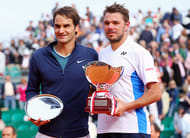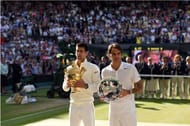At the 2013 Wimbledon championships, after Rafael Nadal went out in the first round, Roger Federer followed suit a day later in the second round against little known Sergiy Stakhovsky from Ukraine. It was Federer’s worst performance in a Grand Slam since his first round French Open exit 10 years back in 2003. Was this the end of an era – the decline of arguably the greatest sportsperson in the last decade?
What happened in the 2013 calender year?
Although his fans feared the worst, Federer, popularly known as “FedEx” or “The Federer Express”, was surprisingly optimistic. When asked about whether his legacy would end here, he said he would reflect on the run “when I’m retired – and that’s not right now.” (Source - The Indian Express)
In the last Grand Slam of the year, Federer reached merely the 4th round. He ended the season with a record of 45 wins and 17 losses (72.58%), which was a sharp decline from the 85.54 win percentage from his previous season.
A series of back injuries that plagued him throughout the year contributed to his poor form. It could have well been over. Fans had started to panic, and which was evident from the large number of pessimistic opinions on Quora about whether he could win a Grand Slam again. The Swiss maestro, however, had other plans.
A new year – A new story
Federer started the 2014 calender year with great determination, losing the Brisbane Open to Lleyton Hewitt in the finals. He then progressed to the semifinal of the Australian Open, defeating big-serving Jo Wilfried Tsonga in the fourth round and reigning Wimbledon champion Andy Murray in the quarters, but he eventually lost to Rafael Nadal in straight sets, who in turn lost to Federer’s Swiss compatriot Stan Wawrinka in the finals.
The spring claycourt season was interrupted when his wife gave birth to twins (again). He reached the finals of the Monte Carlo Masters, losing to Wawrinka, but couldn’t advance any further than the 4th round in the French Open. With his favourite tournament – Wimbledon – about to start, it was high time Federer returned to his very best.
Wimbledon 2014 – The turning point
On his road to the final, Federer defeated Wawrinka in the quarterfinals and comfortably passed through Milas Raonic in straight sets in the semifinal. His opponent in the last match was Novak Djokovic, who had lost his last three Grand Slam finals; the Serb was a man with a point to prove.
At the start of the season, few thought that at the age of 32, Federer still had it in him to reach the finals of Majors, let alone win them. He had defied all odds to reach this stage; could the Maestro produce one more epic performance to win his 18th – the first since he beat Andy Murray at the same stage two years ago?
Federer began the match with confidence, serving with ruthless efficiency (71% first serves in), and making Djokovic work hard during his service games. Although he couldn’t get a break, he did win the tie breaker – the first set was Federer’s.
Federer’s efficiency suffered in the next two sets, however, with his first serve percentage going down. By the end of the third set, Federer was down two sets to one. Yet another five-set final was on the cards.
The 4th set comeback – one for the ages
Although I have been a lifelong Federer fan, the opening games of the fourth set brought back a childhood fear in me – the fear of seeing my idol crash out because he’s outplayed. Federer’s serve was broken, but he broke Djokovic in the next game to make it 3-2. However, Federer was broken again and before we knew it, Djokovic was serving for the championship at 5-3.
Had it been a year or two ago, the match would have ended with that game, with fans blaming Federer’s age for the loss. This would have been yet another instance that showed that Federer was only a human, who had outplayed his golden age – the legend of Roger Federer was history.
Perhaps you need the right situation to get the best out of you. The right combination of aces, inch perfect winners and some lucky review calls later, Federer had won the set 7-5. That was a period that no one could foresee – not even the maestro himself! Such a comeback was only possible at the peak of his career. The Federer faithful had just witnessed a glimpse of the glorious past.
Djokovic bounced back in the final set though, breaking Federer eventually to win the match 6-7, 6-4, 7-6, 5-7, 6-4. However, the tenacity that Federer showed in the fourth set – the fighting spirit – had brought back memories of the ferocious capabilities of the greatest legend to walk the planet. 29 aces and an average speed of 100 mph on his second serve (with just 5 double faults) shows that this man is very high on confidence.
The future looks bright
If you compare his career to the glorious career of his cricketing counterpart, Sachin Tendulkar, you would notice similarities. Sachin had a humble beginning (remember the first two ducks?), followed by super-stardom. In the middle of his career, he lost his way (giving up captaincy), but he came back stronger than ever to win the World Cup on his home soil, before getting a farewell that one can only dream of.
Roger Federer seems to have just crossed his performance dip. He might have lost the final, but he sure is back to his old self. It’s just a matter of time till he wins a Grand Slam again!
Who Are Roger Federer's Kids? Know All About Federer's Twins


